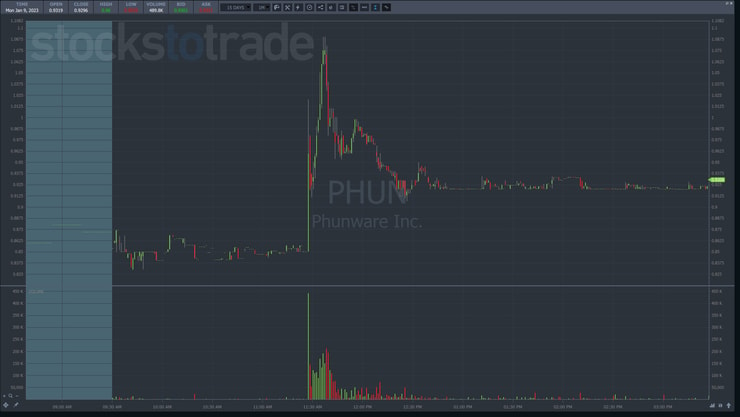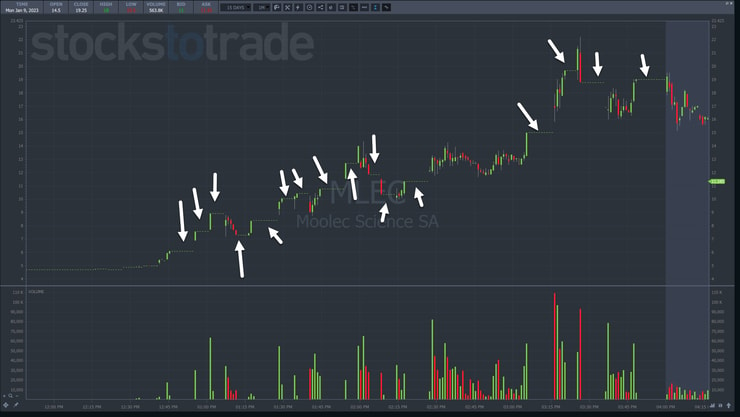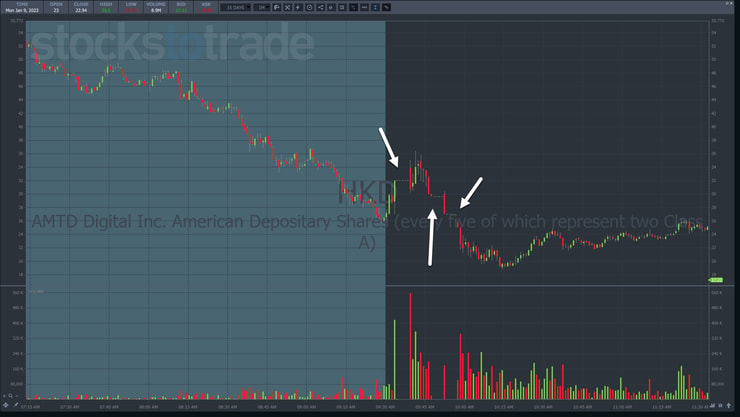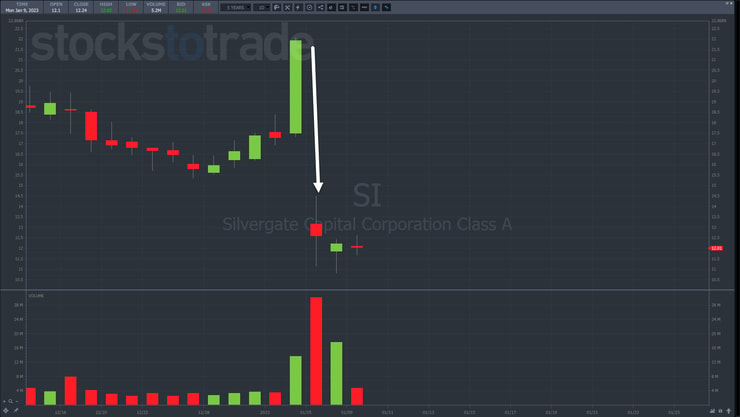January started off strong…
…but not exactly how I anticipated.
Supernovas are popping off left and right…
…stocks like Phunware Inc. (NASDAQ: PHUN), AMTD Digital Inc. (NYSE: HKD)…
…proving the POWER of the ‘January Effect’ that the Winter Glitch exploits.
However, three key trends are forcing me to make some adjustments:
- Premarket pumps that dump at the open
- Excessive trading halts
- Violent moves
So far, my new plan is working perfectly.
And rather than keep it to myself, I wanted to pass along my Winter Glitch blueprint.
In this newsletter, I’ll explain the changes I’m making and why.
Then, you can decide whether to incorporate them into your trading plans.
Table of Contents
Take Profits Quickly

I’m a skittish trader by nature.
If a setup isn’t working, I don’t wait around long.
That goes double right now.
Take a look at the one-minute chart of PHUN:
This stock followed the 7-Step Penny Stock Framework to the letter.
It just happened in minutes rather than over days.
With moves that fast, traders need to act quickly.
Let’s say I wanted to play the panic dip buy.
I would have literally seconds to minutes to get in and out of this trade.
For most traders, that’s a lot to ask.
So, don’t be ashamed to pass on stocks that move this fast.
If you do trade them, keep your size small enough that a miss isn’t going to cost you big.
Learn to Manage Trade Halts
I want to show you a chart of Moolec Science SA (NASDAQ: MLEC) from Friday.
Each arrow points to a volatility halt.
This stock had 16 in one day…all after midday!
I’ve seen more trading halts recently as stocks open and either fall apart or zip higher into a halt.
Halts are dangerous if you don’t understand how they work.
Holding a position, long or short, for five minutes or more is nerve-wracking.
Even a penny stock like MLEC that largely moved higher had plenty of trading halts to the downside.
At each instance, you have to decide whether to hold or cut and run.
These things can get nasty and chop traders right out of their positions.
HKD provides a different example where things looked like they might turn around from a lousy premarket but instead flopped.
In my mind, a trading halt that goes in your favor is a spot to take some profits.
You don’t have to take everything off the table.
However, locking in half or more will give you some comfort to ride the remainder to more money or a stop back at breakeven.
Avoid Premarket Trading

I rarely, if ever, trade the premarket.
It’s the most heavily manipulated time of day when chat groups get together to pump up a stock.
Folks who subscribe to our Breaking News Chat on our Stocks To Trade platform can watch this happen in real-time.
Our analysts call out pumps they see in popular trading rooms that often have a visible reaction on a stock.
I find more consistency and profitability sticking to my 7-Step Penny Stock Framework and locating ideal setups that fit.
Yeah, sometimes that means I pass on trades that end up huge winners.
But in the long-run, it’s helped me maintain a healthy win rate over 75% and a great track record.
Most newer traders get sucked in by the headlines and price action, chasing fliers being pumped by chat rooms.
You’ll do a lot better and go much further ignoring the hype and staying methodical and mechanical.
Bonus Observation

Silvergate Capital Corp. (NYSE: SI) had all the hallmarks of a great overnight long trade.
And guess what happened…
Shares plunged on news the company wasn’t as solid as it seemed.
There are a lot of stocks catching bids right now.
Heck, even Bed Bath and Beyond (NYSE: BBBY) jumped a little after it plunged on bankruptcy news.
Don’t be fooled.
All of these penny stocks will eventually crash.
Holding overnight is especially dangerous right now.
If you want to swing trade, then use the lessons from my Weekend Trader.
Lock in profits early, keep your size small, and act quickly.
There is zero reason to take on excess risk with so many opportunities.
Play quality setups and avoid marginal ones.
It may seem boring, but I’d rather be bored and make money then emotional and broke.
—Tim






Leave a reply